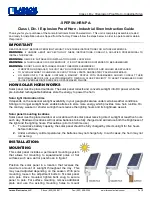
7
ULTRAMATCH PRO SRC2496
2. CONTROL ELEMENTS
The LEDs
32 kHz, 44.1 kHz, 48 kHz, 88.2 kHz
and
96 kHz
read the sampling rate selected with the SAMPLE RATE
switch. If the sampling rate is preset by an external wordclock
or generated via the digital input signal, the LEDs light up
constantly, thus reading the external sampling rate (with a
deviation of ± 2 kHz). The next value (= deviation of >2 kHz)
is displayed by one of the LEDs flashing.
The
CLOCK
switch allows you to select the source
determining the sampling rate at the digital output of your
ULTRAMATCH PRO.
The
PLL LOCK
LED shows you that your SRC2496 is
processing properly the wordclock signals applied.
The
INTERNAL
LED lights up when the SRC2496 generates
the sampling rate by itself (master), which is the preferred
mode for the ULTRAMATCH PRO acting as an A/D converter.
The
EXTERNAL
LED lights up when the sampling rate is
governed by an external wordclock signal. The external mode
also allows you to generate sampling rates at the output
which could not be generated by the SRC2496 as a master
unit.
When the
DIG IN
LED lights up, your SRC2496 uses the
wordclock signal included in the digital audio signal fed into
the unit. This setting is useful if you do not want to convert
the sampling rate, but only the format of the digital output
signal (S/PDIF to AES/EBU or vice versa).
The
FORMAT
switch determines the format of the digital
data stream on the output side, as defined in the Channel
Status data. Available formats are AES/EBU and S/PDIF.
The LEDs
AES/EBU
and
S/PDIF
show the adjusted output
format, which is present at all three digital outputs. Using an
appropriate cable (see chapter 5.3.5) you could also route
an S/PDIF signal from the XLR output to a second unit, in
case the RCA output is already in use.
Use the
WORDLENGTH
switch to select the digital word
length of your choice (16, 20 or 24 bits).
+
If you want to set the digital word length to a lower value
(e.g. to record 24-bit signals with 16 bits on CD, MD or
DAT), we recommend that you switch on the dither
function, so as to limit the distortion resulting from the
omission of the additional bits to an inaudible minimum.
The LEDs
24 BIT
,
20 BIT
and
16 BIT
read the word length
selected.
The
DITHER
switch enables/disables the dither function. The
corresponding LED lights up when this function is active. Heres
a concise explanation of the dither function: Whenever analog
signals are converted to digital (numerical values!), the finite
number of digits available for the mathematical description of
the analog signals (electrical voltages that are constant in the
time and value domains) inevitably result in rounding errors
and misinterpretations of the analog signals (quantization
errors). In particular, signals with a very small amplitude are
affected by an audible system error known as granular noise.
Such errors can be suppressed by adding white noise. This
type of noise has an exactly defined amplitude (minimum
amplitude that can be detected only by measuring instruments
and by no means affects the audio signal) and broadband
frequency distribution and is called a dither signal. Combine
this with the high internal resolution of 24 bits, and you can
generate an audio signal of excellent quality.
Reducing the digital word length (e.g. from 24 bits to 20 bits)
also means a reduction of the resolution. The resulting
misinterpretations, which are more likely to result by this word
length reduction can be purposefully suppressed with the
dither function.
The
EMPH
LED lights up when the emphasis bit has been
set in the output signal. Use the
EMPHASIS
switch to enable/
disable this function. To avoid sound deterioration, the LED
in the output section should read the same status as the
EMPH LED in the input section. In the rare case of a signal
containing an emphasis bit without any treble boost applied,
you can correct this here and switch off the emphasis bit
(detailed information can be found in chapter 3.4).
The
COPY
switch (= copyright) allows you to set the status
of the copy bits in the transmitted data stream. The LEDs
COPY
and
ORIG
inform you about the current status of the
copy protection:
COPY-LED
on
ORIG-LED
on
COPY-LED
on
ORIG-LED
off
COPY-LED
off
ORIG-LED
off
COPY-LED
off
ORIG-LED
on
digital recording only once
digital recording not possible
digital recording unlimited
Tab. 2.1: Overview of copy bit settings
If both COPY and ORIG light up, you can make one copy only.
Subsequently, the data will be copy protected. If only COPY lights
up, digital copies cannot be made. If both LEDs are out, you can
make digital recordings without any limitations. Press the switch
to change the status of the determining bits and allow for
unrestricted copying.
+
This option applies exclusively to S/PDIF signals,
because the Serial Copy Management System (SCMS)
exists in this format only. Signals based on the
professional AES/EBU format can be copied freely.
2.2 Rear panel of the ULTRAMATCH PRO
Fig. 2.6: Mains connector/fuse holder
MAINS CONNECTOR/FUSE HOLDER
. Use the power cord
supplied with the SRC2496 to connect the unit to the mains.
Please note the instructions given in chapter 1.2. Blown fuses
should only be replaced by a fuse of the same type and
rating.
Fig. 2.7: Serial number on the cover
SERIAL NUMBER
. Please take the time to fill in and return
the warranty card within 14 days after the date of purchase,
so as to benefit from our extended warranty. Or register
online at www.behringer.com.


































